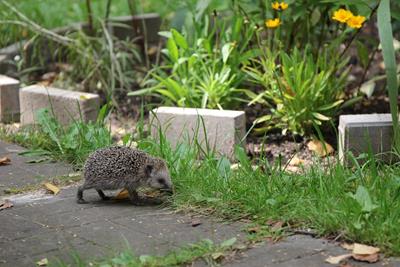
Ten of the most popular flowers to plant in Autumn
| 1. Daffodils | 6. Tulips |
| 2. Crocus | 7. Rudbeckia |
| 3. Snowdrops | 8. Bluebells |
| 4. Aconites | 9. Asters |
|
5. Hyacinths |
10. Japanese Anemones |
Autumn is the perfect season to plant flowers, bulbs, vegetables, and herbs, with warm soil and steady rainfall. This helps them to establish roots before winter, so you can create a thriving spring garden with a variety of colours and scents for you to enjoy, and pollinators will love.
Gear up for autumn with our essential guide to plant growth and planting tips.
Bulbs to plant in autumn
To help you choose which flowers to plant in Autumn, here are a few suggestions to get you started:
Crocus
Crocus bulbs will flower around February if you pick a sheltered but sunny part of the garden and plant them in peat-free compost towards the end of September. If plantingin pots, put the crocuses at different depths to create layers of colour.[1]
Snowdrops
August to September is the best time to plant the delicate and elegant snowdrop. They thrive in the shade, under trees like the silver birch, among grasses, and in window boxes. Use plenty of manure or compost before planting.[2]
Winter aconites
If you want to bring pollinators to your garden and attract insects in the springtime, the yellow winter aconite is a wonderful choice. It loves a sunny spot or shady deciduous trees at a 5cm depth and 5cm apart.[3]
Hyacinths
The lovely hyacinth will fill your garden with scent and add a splash of colour with its stunning variety of hues. To help them bloom beautifully in late spring, plant them between September and December in well-drained, light soil, with a 2cm layer of grit.[3]
Tulips
The best time to plant tulips is between October and November as the cooler temperatures helps trigger blooming. This also helps protect them from potential fungal disease in the soil, such as Tulip fire[2]
This causes the leaves turn brown and appear scorched, so you’ll need to remove affected bulbs and avoid planting for a few years to prevent further issues.[4]
Rudbeckias
The perennial rudbeckia will spread by 40cm, so they're perfect for large pots on the patio or in beds and borders. To help these terrific pollinators thrive, plant them in heavy soil during the spring or autumn.[3]
Bluebells
You can plant this cultivated wildflower between August and September, and it will bloom beautifully from April to May, bringing vibrant colours and delightful scents to your garden. Bluebells blossom under the shade of deciduous trees and shrubs.[3]
Asters
The sprightly, spiky blooms of the Aster create pops of colour during the spring.. The planting period is July to late September, when no more frost is likely. They thrive in pots and borders around 20cm apart.[3]
Japanese anemones
Plant your anemones in October, and they'll bloom in the spring and summer, producing delicate blooms that will be the highlight of your garden. They appreciate a mix of shade and sunlight and drained and organic-rich soil.[5]
Vegetables to plant in autumn
It’s not just about flowers of course, if you’ve got the space to grow some vegetables, try:
Radishes
If you’re interested in planting fast-growing vegetables this autumn, consider radishes. Plant your seeds from March to late September to enjoy fresh, crisp salads harvested from April-to-October.
Turnips
Another quick-growing vegetable that creates a steady supply is the traditional turnip. Sow turnip tops in the autumn, in warm, wet soil protected from slugs, and you’ll harvest these reliably tasty greens in the early spring.[6]
Carrots
Supermarkets now sell a mix of rainbow coloured carrots, but it's easy to grow your own in the autumn. There's even a frost-hardy variety called Carrot Autumn King that you can leave over winter and harvest continually.[7]
Spring onions
You can enjoy the delightful peppery sweetness of spring onions in your stir-fries and salads from May to April. To achieve this, simply plant the seeds around March and September of the previous year. This easy-to-grow veg also thrives in pots.[2]
Onions
By planting onion sets (mini onions) in the autumn, you'll be able to enjoy an earlier harvest. Ensure you buy a variety that doesn't mind the cold and develops fast. Protect your rows of onions with nets to protect them from birds.[2]
Potatoes
To savour a delicious harvest of potatoes at your Christmas dinner, consider planting them from late summer to early autumn. This process is known as second cropping. Grow them in pots or grow bags and protect them from frost.[8]
Spinach
Sow your spinach seeds in rows or pots 1cm deep in September and October in sun or semi-shade. Then wait for 10 weeks before harvesting. You must protect the spinach from frost with a cloche or fleece.[9]
Kale
While nutritious kale can be quite pricey at the supermarket, the good news is that it is easy to grow at home. Plant it in July and August and protect it from birds with netting. It likes well-drained soil and should be watered well after planting.[9]
Lettuce
Autumn is a wonderful time to plant winter lettuce varieties such as Arctic King and Winter Gem (Cos), as they thrive in the cooler temperatures of this season. Sow them between September and October and pick them in the spring.[9]
Cauliflower
Plant your cauliflower seeds in a sunny spot in September or October for a May harvest. You'll need a fertile, well-drained soil to protect them from frost.[10]
Swede
You can grow swede in autumn, but it is typically planted in spring and summer. Plant them in early autumn or even late summer and harvest them in the winter.[11]
Herbs to plant in autumn
Flat leaf parsley
Parsley is a versatile herb in anything from salad to sauces. You can grow the flat leaf plant in a pot indoors or replant it outside in autumn in a frost-free area. Parsley is slow to germinate from seeds.[12]
Chervil
If you’re deciding which herb seeds to plant this autumn, chervil is a great option. Germinate this hardy herb from seedlings in a warm space indoors during the autumn and then plant them out under cloches for a harvest till May.[13]
Coriander
You can plant coriander in well-drained soil under a cloche or other cover and still pick it in May. Coriander prefers cool, damp weather and partial shade.[14]
Autumn jobs for your garden
The garden requires quite a bit of tidying and preparation from September to November to ensure it's ready for winter. We've listed the main activities and why you should do them in autumn.
Mulch your flower borders: Mulching your borders thoroughly will protect tender plants and suppress weeds before they have a chance to germinate.[9]
Clear leaves: Rake up fallen leaves from the lawn and compost them or use them as mulch,[9] then aerate the grass and sow grass seed.[3]
Find out how to aerate your lawn
Clean your flowerpots: Take time this November to clean and disinfect your flowerpots. It will help to prevent disease and ensure they’re ready for upcoming planting.[3]
Pruning: In September, take care to deadhead your annuals to encourage new blooms. Prune shrubs and rambling or climbing roses after they finish flowering, and harvest any crops you’ve grown.[9]
Cut back herbs: For thriving herbs through the winter, trim them back and bring any potted varieties indoors for protection. Chives will continue to grow on a warm windowsill, as does lettuce, unless you have a greenhouse
Split your perennials: To maximise your plants’ health and ensure they continue to thrive, divide them in September.[9]Pot any tender perennials into pots under cover so they survive the lower temperatures.
Prepare the soil well: Enrich and suppress weeds by digging green manure crops into your flower and veg beds during October. They enhance the soil's fertility and naturally decrease pest problems without relying on chemicals.[3]
Plant bulbs for spring: Plant daffodils, narcissus and crocus in October and early November to create bright, colourful hanging baskets and containers.[3] Lift out begonias and dahlias before frost hits them.[9]
FAQS
What grows fastest in autumn?
Leafy greens grow the fastest in the autumn. We’ve ranked them from fastest to slowest with their harvest times.
- Rocket: Baby leaves available in 3-4 weeks
- Pak choi: As little as 6 weeks after planting[1]
- Lettuce: 4-10 weeks depending on the variety
- Spinach: 60 days to harvest
- Collards: Harvest about 100 days after planting.[2]
When should you start autumn planting?
You should start autumn planting in September and October, while the soil is still moist and warm and before the cold and frost of winter sets in.
Find out more about Ageas Home Insurance
Sources
[1] Haskins
[2] Hillier
[3] Suttons
[4] Ashridgetrees
[6] Proctors nursery
[7] The Guardian
[8] Simply seed
[9] Thompson morgan
[10] Garden organic
[11] Rootsplants
[12] Rocket Gardens
[13] First tunnels
[14] Sarah Raven
[15] Growveg
[16] Growseed


